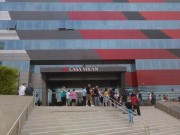Report Calcio 2017 – The Italian Football Federation in collaboration with AREL (Agency for Research and Legislation) and PwC (PricewaterhouseCoopers) developed for the 7th consecutive year “Report Calcio”. It was presented at the multifunctional Hall of the Presidency of the Council of Ministers in Rome.
In eight chapters all the issues related to sustainability, development, and promotion of football in Italy were addressed. The presentation was attended by FIGC President Carlo Tavecchio, AREL’s Enrico Letta, PwC’s Emanuele Grasso and UEFA’s Andrea Traverso, the manager of the Licensor and Financial Fair Play section.

In reference to the 2015-16 season, the numbers published on Report Calcio 2017 highlight how FIGC represents the biggest Italian football federation by far. The total memberships amounted to 1,353,866 in 2015-2016, of which 1,062,294 are registered players, 24,757 coaches, 33,674 referees (including over 1,600 women) and 233,141 executives. There are also 13,120 companies and 70,868 teams, which played a total of 583,340 official games (including 378,547 at the youth level, 201,406 at the amateur championships and 3,387 at a professional level).
Every day, nearly 1,600 official matches with federal referees are held in the 17,932 sporting camps approved in Italy. The total number of young players in the tournament is 827,784 (including youth and school memberships, with the addition of “young amateurs”, “youngsters” and Juniors).
Report Calcio 2017 – The National Teams
In the 2015-16 season, the 17 Italian national football teams have played 184 games in total, winning 94, losing 38 and collecting 52 defeats. The 5 matches played by the Italian national team during the UEFA European Championships 2016 produced a total audience of 247,564 spectators and an audience of 17.6 million viewers per game (with an average share of 70.9%).

In the top 50 positions of the most popular TV programs in Italy, there are 49 football matches, including 45 of the national team. The total audience generated by the Italian National Representative in the course of 2016 amounted to 163.2 million viewers. In 2016, the total number of viewers who have seen worldwide programs with images and content relative to the Italian National first and Under 21 teams (cumulated audience) was over 2.2 billion, with a duration of over 5,000 hours of TV broadcast.
With regard to the Licensing and Merchandising program, the collaboration with PUMA License resulted in the sale of about 1.2 million articles in 2016, of which about 80% were out of Italy.
Report Calcio 2017 – Professional Football in Italy
Italian professional football is a sector of great importance in economic terms. Over the course of 2015-2016, Italy recorded a 30.6% (from 536 to 372 million euro) negative net income and an improvement in shareholders’ equity of more than 4 times (from 37 to 151 million euro). This was due to a significant increase in the level of the recapitalization by the owners of professional clubs (from 299 to 484 million euro).

In 2014, Italian professional football fiscally contributed €944.6 million, which is €1,073.3 million if we consider the revenue from football betting (5.2% higher than in 2013). At the economic level, the football sector accounts for 46% of world business sports turnover (26.6 billion euro compared to 57.3 in total). Between 1996 and 2015, the total revenues of the European top divisions grew on average 9.3% a year (from 2.8 to 16.9 billion).
Report Calcio 2017 – Top Division revenues
Labor costs grew significantly (+10.3%), reaching 10.6 billion in 2015. Thanks to the introduction of Financial Fair Play, the economic imbalance appears to be attenuating (aggregate loss went from 1.7 billion in 2011 to 0.3 in 2015).
Among the top 10 top divisions, Italy ranked fourth in average club revenues (€95.2 million), surpassed by England (220.2m), Germany (134.5m) and Spain (102.5m), but ahead of France (70.9m) and Russia (46.3m). Turkey, the Netherlands, Portugal, and Scotland are between 40 and 10 million.

There is also a progressive trend. Clubs of the main Top Division are acquired by foreign shareholders. Of the 13 major European championships, a total of 44 foreign properties (including 28 in the first and second division of English professional football), mostly from the United States, China, Russia, Thailand, and Malaysia acquired football teams.







































